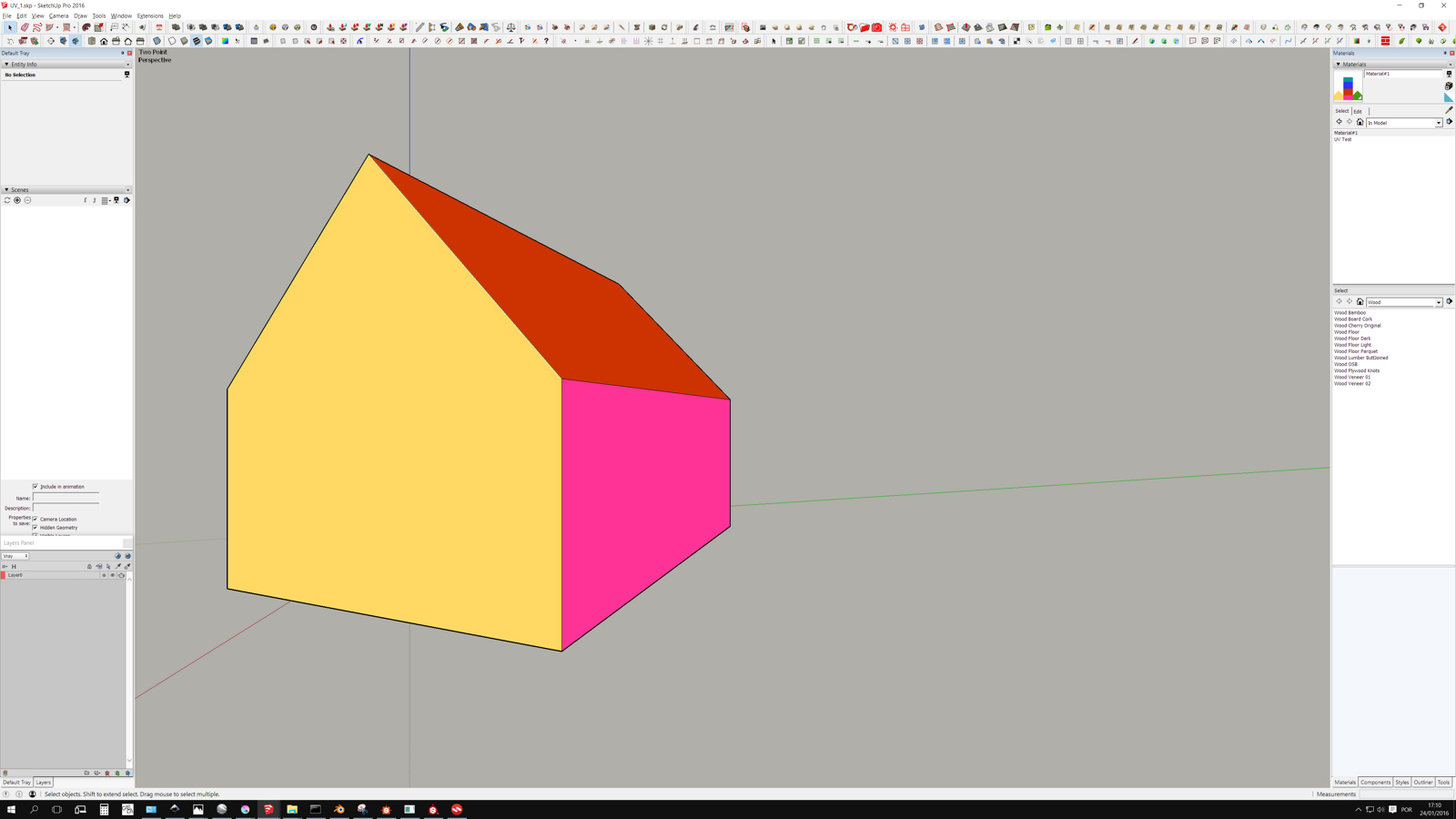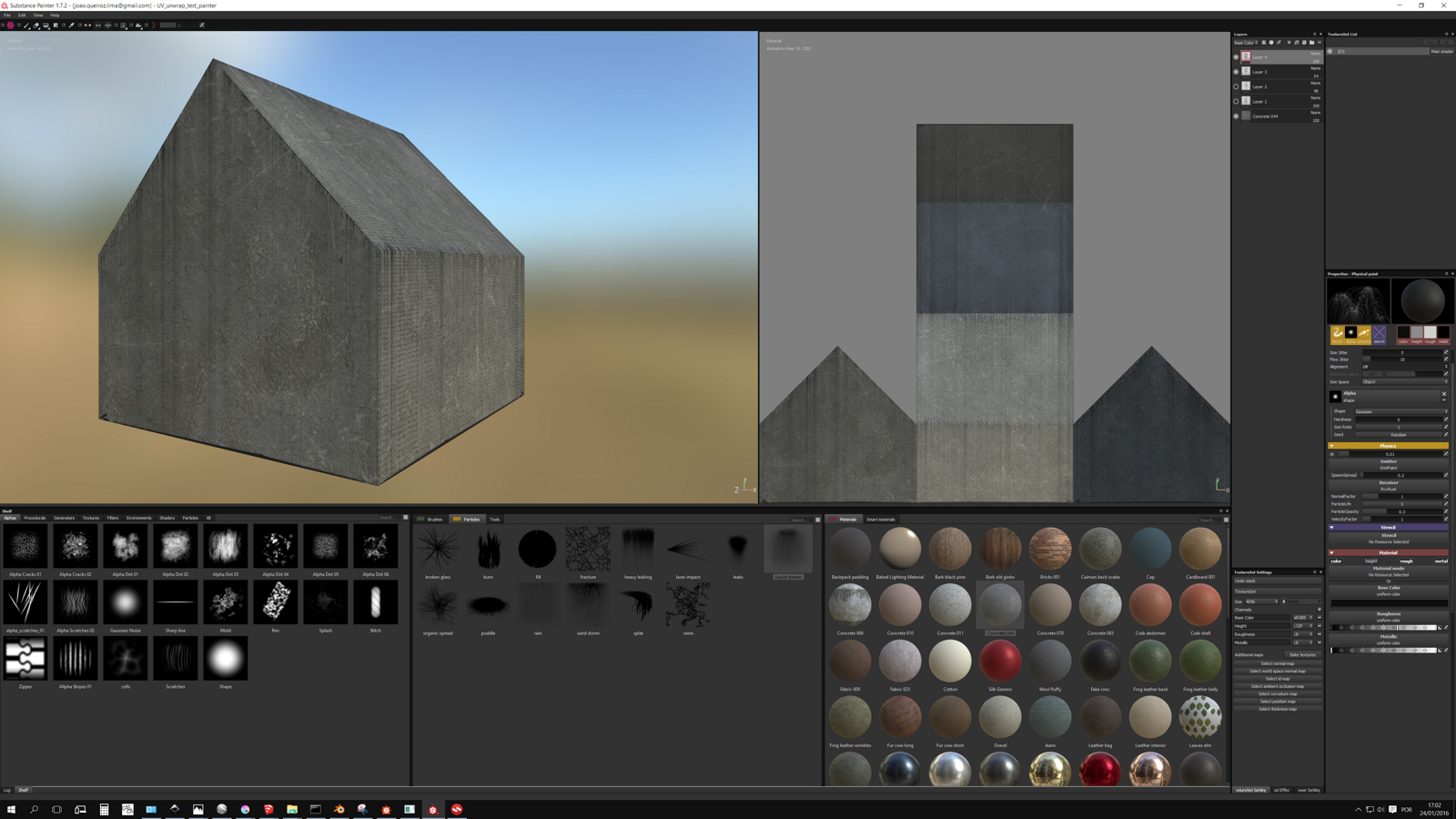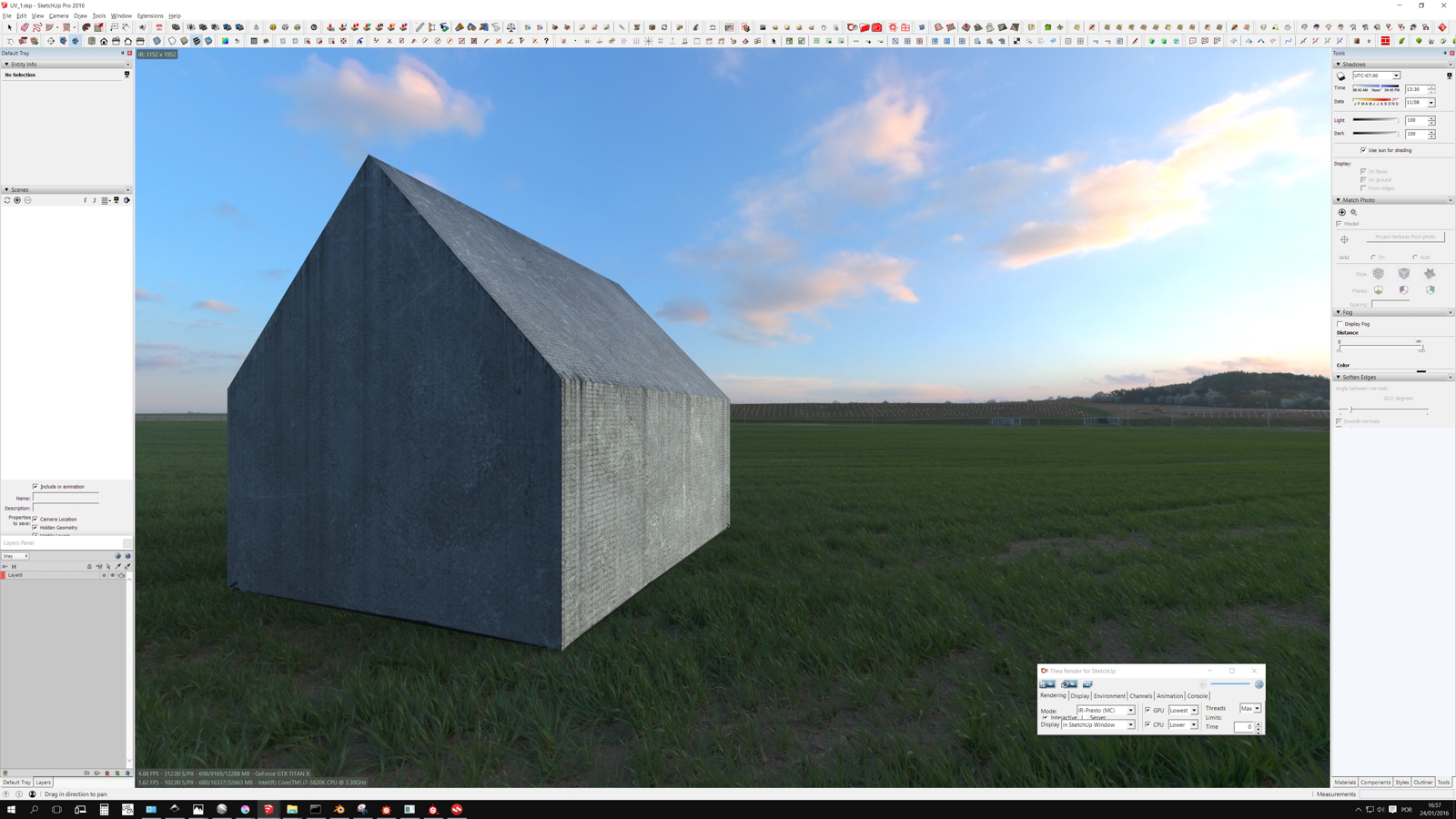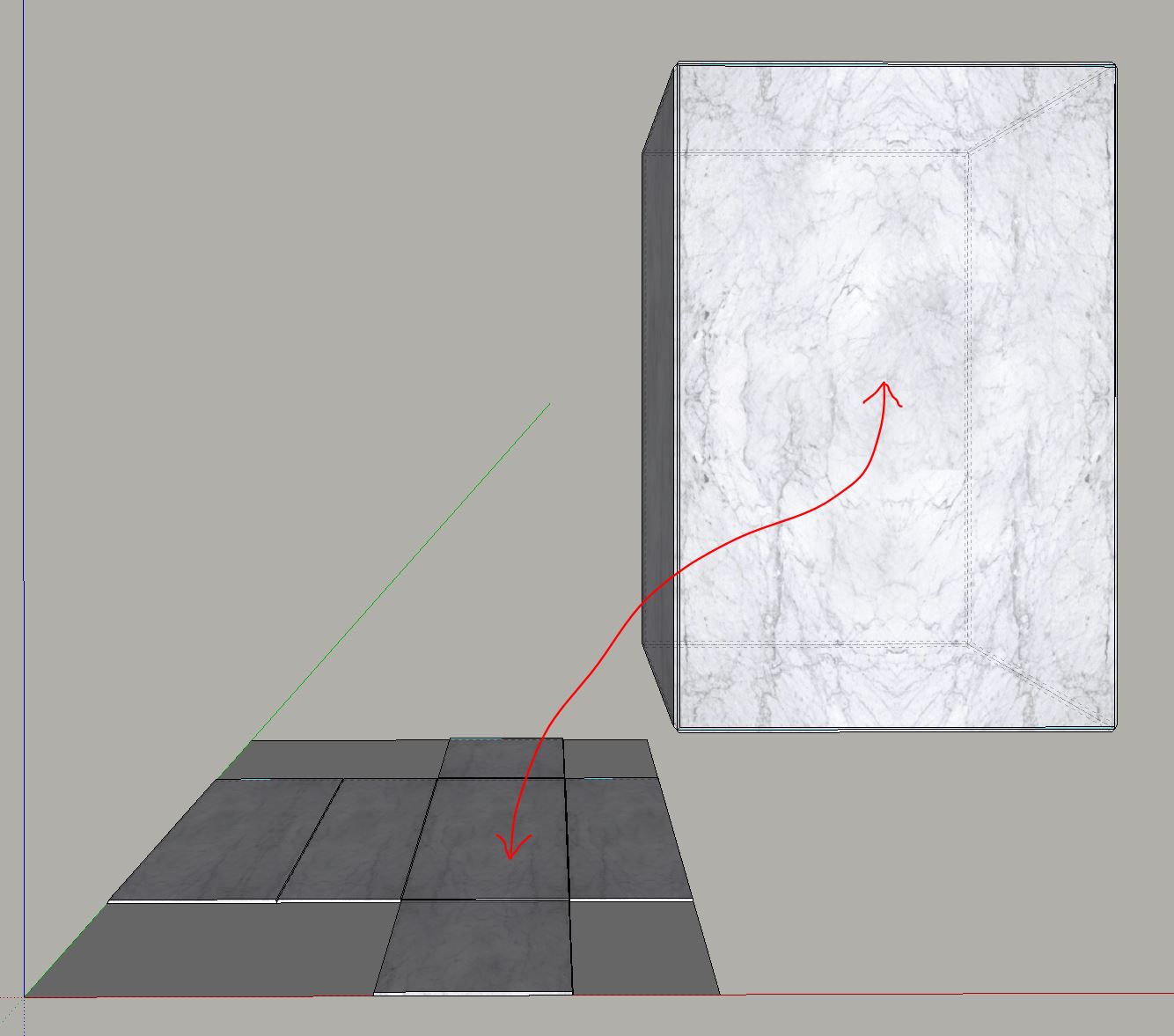Successful UV Unwrap inside Sketchup!
-
@rich o brien said:
But what is missing here is the relationship of the UV texture Space to the mesh. They are out of sync. Your blender screen grab shows the mesh is scaled compared to the resolution of the image. Scale it down and it will stop tiling.
I imagined I could do that, but I don't know how to do it perfectly and I'm afraid I'll get seams at higher resolutions.
@unknownuser said:
What would be interesting to know here is what are the dimensions of the mesh and what are the SketchUp dimension in the material editor for your texture.
You're a genius, I didn't assign any set size. I'll try it asap!
I'll also share the current model as I forgot to in the first post. For post coherence I will post it there.
-
You were being a genius but I was being Dumb!
Of course the textures are at model size. They've been combined from a set of faces that is exactly at real size.
So they fit perfectly... However I think I might have found the solution!!!
Take a look at this:
SCALE
While Sketchup Materials and Blender Materials work the same, and define the scale of the texture in model units. 15m in sketchup material is 15m in blender material, texture UV behaves differently.
A texture UV scale is simply put 1! That is 1 unit in Sketchup and 1 unit in Blender. However you can't see UV scale in Sketchup (probably you can in SDK but users have no access to it without plugins...)
Of course in Blender you probably can, in the UV editor! There, you clearly see that the texture is, in fact 1m!
You can clearly see that there are five tiles in the house wich is 5mX5m...
POSITION
You can clearly see the relationship right?!
I haven't checked but I'm pretty sure they texture origins are the exacly the same between Sketchup and Blender.
In Sketchup I copy+pasted UV's from the texture in the bottom to the mesh in the top.
Now I know what I did and I'm absolutellty sure I know how to fix this!
Rest assured guys, I don't know how to write a single plugin, but today I will manage to successfully UV unwrap a texture in Sketchup!! And it's pretty easy too!
As soon as I have it controlled I will make a tut on it!
-
it'd be easier and quicker to just unwrap in blender. but keep on trucking
-
Here you go! Perfect UV Unwrap Inside Sketchup!!!
Who wants a tut on how to achieve this manually with existing plugins?
Who wants to develop an UV Unwrap plugin with me?
-
There's a flaw in using Alex' flatten tool. It caves when the face in non-planar.
You need a tool that uses LCM or equivalent when flattening to a 2D space.
-
@rich o brien said:
There's a flaw in using Alex' flatten tool. It caves when the face in non-planar.
You need a tool that uses LCM or equivalent when flattening to a 2D space.
What is LCM?
-
Sorry LSCM
Alex' tools doesn't trap for this when going from 3D form to 2D space.
-
UV mapping in SU, the "holy grail".
Good luck, I will be following your adventure with jaded optimism.
-
You don't get that with this method.
For what I did understand with that scarse info is that LSCM method is great if you want to stretch the unwrapped faces to fit the bigger area of the texture map as possible.
That is ideal for bigger texture details with smaller maps.
With orthogonal meshes my method is able to make it all seem very right. With triangular and irregular meshes or organic meshes, my method will make every triangle fit the texture without any kind of deformation.
This is not very good if you want to optimize texture area... nor is it very good if you want to 2D paint your texture map in an image editor as, if your model is very organic, you will get a lot of islands and can't easily paint through them. However you can manually define your islands easily enough...
What you can achieve with this method, however, is a that you can create an UV Unwrapping with NO pixel distortion at all.
You can also adapt it very easily to a SubD workflow.
It's not great for a thousand faces as, right now, it implies manually following a map with paint bucket. But it's great for Simple shapes... I'm an architect and I'm thinking architecture here...
It's also the perfect method for a Sketchup+Substance workflow (I think) as substance is able to bake positional, normal, curvature, etc maps into an UV unwrapped model.
With these maps I'm hoping I can then generate all kinds of effects independently of face orientation and as I think I will be able to use Substance to ignor Islands and tile throgh seams, I'm hoping I can achieve something good here...
-
@JQL You don't think its more fast and easy to just export the object to Blender, do an unwrap there and import the obj into SketchUp again?
-
@kaas said:
@JQL You don't think its more fast and easy to just export the object to Blender, do an unwrap there and import the obj into SketchUp again?
It is! That's pretty clear...
But before I tried this I didn't really understand what the hell was happening...
I don't master blender, not even close, so I had almost no control of what I was doing, I had almost no notion of what was happening and I was't getting any useable results. So I also didn't understand exactly what was UV unwrapping.
Now I do, and this was the first time I managed to unwrap exactly how I was imagining things to be.
With this Unwrap method inside Sketchup I manage the following things:
- Texture the way I want to with the tools I happen to be confortable with;
- Wich means texturing as I please using Sketchup and an Image Editor;
- Model in Sketchup and export directly from sketchup to Substance;
- Remodel my unwrapped meshes in Sketchup knowing what I have to do to keep UV mapping, rebuild it or simply ignore it...
I was hoping these dablings could also poke someone to further take on this exploration and develop an UV unwrapper for Sketchup, inside Sketchup...
I already have a Lot of ideas of how it should work and what other features it should have.
I'm seeing Huge potential workflows using only native tools and Substance...
Obj Out Obj In wouldn't give me such control...
But now I know what I'm doing, I really know when I should use Blender for Export/UV Unwrap/Import and when I can stick with SU.
-
Several years ago I made this proof of concept:
http://sketchucation.com/forums/viewtopic.php?f=180%26amp;t=39198 -
Pixero, I didn't know about that, will you ever push it forward?
-
I think I have taken it as far as my ruby skills go.
Hopefully someone could build upon my idea and implement a better unwrapping algorithm.
There is code available for unwrapping that might be possible to convert to ruby.
Feel free to use the code if you want. -
Even though I'd love to, I'd first have to learn Ruby from scratch and for that I'd need free time.
I've got no free time on my hands... I've found this way to unwrap and I've got Blendup so I can do both simple and complex unwrapping spending way less time than developing a full plugin.
I think this could be a job for some skilled developer and preferably someone that as dealt with geometry unwrapping or texturing plugins...
What I could easily do is suggest UI or Worflow suggestions, but even there, I think there are people that are far more used to this than I am. I've just found a way to do exactly what I wanted, and even if I could have even better ways to do it, I think that is enough for me.
I'm probably doing a Tut on this one of these days.
-
And there you go.
A quick trip from Sketchup to Substance Painter and back to Sketchup...



-
I tried another procedure wich relates texture and geometry.
Instead of having Unwrapped faces I've acomplished Unwrapping components.
What this allows is a component face to be edited and when that happens it get's changed in the geometry attached to the 2d map.
You can then scale it rotate it and position it on the map as you will, and then adapt the map to fit the altered component.
Here's a chanfered model created with a projected texture on the 6 components. As I alter the component's shape the texture keeps projected an UV unwrapped. If I alter the component's perimeter, I have to alter the texture afterwards using, redrawing the square, intersecting square face with components and painting the projected texture on the new faces. Then recombine textures and reproject them on component's faces.

I know it's hard to master and convuluted, but it opens up new possibilities.
The plugin I used to Unwrap components is Flattery... it can make all components Unwrap and in that simple box it took only two moves! Only after unwrapping components as faces did I alter the components to be solids with chamfered edges...
Exporting to any format gets a map perfectly unwrapped.
Here's the model to try yourselves:
-
@jql said:
A quick trip from Sketchup to Substance Painter and back to Sketchup...
Care to share a step-by-step guide how you managed to achieve this...?
Looks great...!Have you tried more complex geometry...?
-
@frederik said:
@jql said:
A quick trip from Sketchup to Substance Painter and back to Sketchup...
Care to share a step-by-step guide how you managed to achieve this...?
Looks great...!Have you tried more complex geometry...?
Yes I did, and a VERY VERY improved workflow using components for faces!
This is becoming unbelievably simple.
The Step by Step guide is definetelly on my plans, but I'm getting deeper and deeper on possibilities and tests!
It's amazing what we can achieve using just sketchup if you know how everything is connected, and also, doing the wrong thing it's incredible how everything fails.
Basically let me tell you that Blender seems the devil but it's actually your friend even if you think it's not, while Sketchup looks very friendly and nice, but is a damn liar! All Sketchup want's is for you to be happy but ignorant, while blender shows the world as it is!
When you want to know something important, Sketchup is a father that sits with you at the playground telling you about the birds and the bees and while Blender is the kind of father that talks to you about sex...
Sketchup facilitates things so much that you won't realize what you can achieve by yourself!
-
Advertisement









